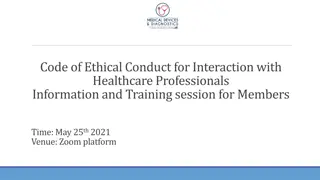Ethical Issues in Healthcare Practice: Addressing Challenges and Solutions
Explore the complex ethical issues faced by healthcare practitioners in resource allocation, worker rights, moral distress, stigma, racial bias, individual vs. public health priorities, and more. Dive into case scenarios highlighting ethical dilemmas like accommodating immunocompromised residents during COVID-19.
Download Presentation

Please find below an Image/Link to download the presentation.
The content on the website is provided AS IS for your information and personal use only. It may not be sold, licensed, or shared on other websites without obtaining consent from the author. Download presentation by click this link. If you encounter any issues during the download, it is possible that the publisher has removed the file from their server.
E N D
Presentation Transcript
Agenda Logistics 5 minutes Brief outline of ethical issues --10 minutes Part 1: Ethical issues for residents --20 minutes Part 2: Ethical issues for patients and practice --20 minutes Wrap up - 5 minutes Summary Remaining questions Plan for next steps 2
Ethical issues For Practice For Practitioners Resource allocation Worker rights and responsibilities Moral distress & moral panic Stigma and racial bias Individual care vs. public health priorities Education vs. public health priorities Essential vs. nonessential care Resource allocation during scarcity Telemedicine benefits/limits Health disparities, stigma/bias Counseling during uncertainty 3
Ethical issues For Practice For Practitioners Resource allocation Availability of PPE Worker rights and responsibilities Duty of care Redeployment Essential staff/activities Allocating risks/burdens Fair division of labor Personal circumstances Moral distress & moral panic Role of social media Stigma and racial bias Individual care vs. public health Education vs. public health Essential vs. nonessential care Urgent visits vs routine follow up Who decides? Telemedicine benefits/limits Health disparities, stigma/bias Resource allocation during scarcity Counseling during uncertainty 4
Ethical issues For Practice For Practitioners Resource allocation Worker rights and responsibilities Duty of care Essential staff/activities Allocating risks/burdens Fair division of labor Personal circumstances Moral distress & moral panic Role of social media Stigma and racial bias Individual care vs. public health priorities Essential vs. nonessential care Urgent visits vs routine follow up Who decides? Vision vs life-threatening? Telemedicine benefits/limits Health disparities, stigma/bias Vulnerable populations Resource allocation during scarcity Counseling during uncertainty 5
Case Scenarios For Practitioners 6
CASE 1 Resident Z has a rheumatologic disease, currently treated with biologics, and is scheduled to covering ED/Consults at Bayview. He is very concerned about potential exposure to COVID-19 as it represents disproportionate risk to his health compared to non-immunocompromised colleagues, especially in this clinical role where he expects to see patients without regular access to PPE. He requests to be moved to a rotation with minimal in-person patient contact. 7
CASE 1.1 Resident Y returned from parental leave a few weeks ago. Resident X, now on vacation, is called in to cover in place of Resident Y, a resident in the same year, because of concerns of increased risk of spreading COVID 19 to Baby Y and Partner Y. Resident X, just finished multiple busy clinical and surgical blocks back to back, and was at a physical/mental breaking point, only staved off by the promise of the upcoming 2-week break, which is now cancelled. 8
CASE 2 Your Asian attending leads inpatient rounds. When the attending introduces themselves to the patient, the patient looks uncomfortable and the patient s mother blurts out, I don t want my daughter or grandchild exposed to the Chinese virus! Please find another doctor to take care of my daughter-- there must be people on your team who are lower risk! 9
Case Scenarios For Practice 10
Case 3 A 45 year old woman calls you. You last saw her in GES clinic 9 months ago. She is undocumented and works cleaning hotels. She is the sole provider for three children at home. She has hypertension and DM and follows for diabetic retinopathy. She reports 1 week of cough and now has 48 hours of mild shortness of breath. Her employer has told her that she must come into work and wants a letter from you saying she is healthy enough. She does not have a PCP and asks if you can write the letter. 11
Case 4 You are a high volume retina specialists, seeing ~50-60 patients/day. Due to the COVID-19 pandemic, you have been asked to reduce your clinic schedule to only emergency patients. While none of your patients are in a life threatening situation, you are concerned about vision threatening consequences of delaying visits. 12
Case 5 The mother of an ex-24 week premature infant, who is now 37 weeks PMA with Stage 2, Zone 2, pre-plus disease (pre-threshold retinopathy of prematurity (ROP)), is scheduled for 1 week ROP follow-up eye exam. Mom calls to say she s cancelling the eye appointment because she can t risk her baby getting COVID-19 since he only just came home and I don t want him to die. 13
Ethical issues For Practice For Practitioners Resource allocation Worker rights and responsibilities Duty of care Essential staff/activities Allocating risks/burdens Fair division of labor Personal circumstances Cohorting? Moral distress & moral panic Role of social media Stigma and racial bias Individual care vs. public health priorities Practical guidance for minimizing nonessential patient contact Essential vs. nonessential care Urgent visits vs routine follow up Who decides? Telemedicine benefits/limits Health disparities, stigma/bias Resource allocation during scarcity Counseling during uncertainty 14
Questions? mcolli36@jhmi.edu jcarrese@jhmi.edu 15























